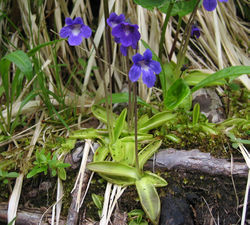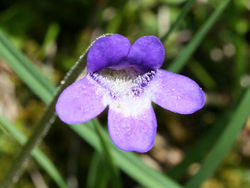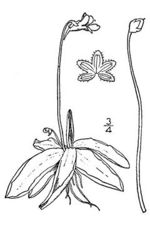Common butterwort
| Common butterwort |
|---|

|
| Scientific Classification |
|
| Binomial Name |
|
Pinguicula vulgaris |
| Photographer: Pavel Daněk |
The Common Butterwort is an insectivorous plant species of butterworts known by the scientific name Pinguicula vulgaris. The common butterwort lives in soils lacking usable nitrogen, and obtains nitrogen from the insects it digests. These plants, however, contain chlorophyll for photosynthesis and produce their own sugars.
Body Design
This species was thought to have had magical properties. The juices from the leaves were once rubbed onto cows’ udders as thought to protect the milk (and resulting in butter)from evil influences. The butterwort produces bright purple flowers. Such color has earned the species Pinguicula vulgaris Bright yellow-green leaves feature numerous glands that secrete a sticky fluid which attract pollinating insects. When the insects get stuck in the sticky fluid , the leaf begins to slowly curl inwards and With time the insect will be digested by the butterwort.[2] The Common butterwort is a perennial plant with thin roots that spends the winter as a dormant rootless bud. Places poor in nutrients Is commonly where you can fin these insectivorous plants. Other plants living in such habitats, such as sundews, have also developed this trait.
With the height of 10-20 cm (4-8 in) and a strongly purple flower, also living in Fens, springs, shore banks, damp meadows, gravels, damp rock walls, it is no surprise it attracts insects of various species. The stem on a butterwort is leafless on the upper part of the plant ( a long, leafless flower stalk coming directly from a root.) with glandular hairs. The flower is thought to be the main attraction to the unsuspecting victim. The flower is a strong purple color and is 15-25 mm long. The leaves on the butterwort are short stalked, long green, with the edges curling upwards. a sticky surface with glandular hairs and secreting glands cover the leaf. The fruit is a yellow-brown color, egg shaped with a capsule open at the tip. The typical flowering time is June through July.[3]
Life Cycle
This carnivorous plant thrives in the mountains as well as in the lowlands. [4] During spring, the butter wort’s cycle begins by the opening of winter buds, called hibernacula (meaning: a bud, case, or protective covering that a plant uses to survive the challenging environmental conditions during a dormancy period) , and its first carnivorous leaves begin to sprout. Those leaves are followed by the flowers that sprout during the Summer. New leaves are constantly being produced throughout the season. Near Autumn, or even earlier, if conditions are not harsh, the next bud case is revealed in the center of the rosette. Then the leaf producing stops and the old leaves decay slowly. The butter wort plant, reduced now to a small bud case , is ready for Winter and to begin the next cycle.[5]
Ecology
The common butterwort is found in coastal British Columbia, and all across Canada at higher latitudes, stretching south into the northwestern coastal US. It is found through much of northern Europe and some parts of Asia as well. The common butterwort is found in moist sites from low to subalpine elevation in coastal British Columbia, like fens, bogs, water seeps and swamps. [6] The common Butterwort grows in a variety of climates they are very similar to Sundews however differ by being the second most diverse of the carnivorous plants with respect to growing conditions. Most of the Butterworts grow just about anywhere in the northern hemisphere, there are some places along the Pacific coast of southern South America. Butterworts can grow in deserts alongside cacti; in arctic regions on mosses, on trees, as 'air' plants, or as previously said in damp environments. Besides this, some are temperate and require a dormancy period, some are from slightly warmer areas, and some tropical. If you acquire a Butterwort, it is best to know what kind of butterwort it is so that you can give it the best possible growing conditions [7]
Leaves
The common butterworts leaves are really an interesting feature. On the inside of the narrow curled leaves of the butter wort there are tiny hairs that secrete a sweet sticky substance. When an insect touches these hairs , the leaf curls shut until the insect is fully digested. However insects are not the only thing the common butterwort eats. They can digest seeds, wheat, and even more. The leaves are short-stalked. And have a sticky leaf surface with glandular hairs and secreting glands. The secreting glands are used for attracting insects. [8]The process begins by an insect to become attracted by the sweet smell the leaves give of and nice attracting colors the flowers have. The insect then can get stuck on the leaves when it crawls onto them. The leaf then folds over the insect then begins the digestion of the insect,which can take up to 2 days. [9]
References
- ↑ Pinguicula vulgaris Common butterwort USDA Plants Detabase. Web. accessed May 13 2014. author unknown.
- ↑ . Common butterwort (Pinguicula vulgaris) arkive. Web. May 13 2014. Author Unknown
- ↑ Common Butterwort ‘'Nature Gate. Web. date of access may 13 2014. Author Unknown
- ↑ Pinguicula vulgarism butterwort ‘'practicalplants. Date of access May 28 2014. Author Unknown
- ↑ Pinguicula Vulgaris Seeds rarexoticseeds. Date of access may 28 2014 Author Unknown
- ↑ . Common butterwort, bog violet, marsh violet, butter-plant • Pinguicula vulgaris Biodiversity of the Central Coast. Web. date accessed may 13 2014. Author Unknown
- ↑ Butterwort Plant Pinguicula sp. Butterwort. Web. Date of access may 13 2014. Author unknown
- ↑ Common Butterwort ‘’Nature Gate. Date of access may 28 2014 Author Unknown
- ↑ Pinguicula Vulgaris Seeds rarexoticseeds. Date of access may 28 2014 Author Unknown


